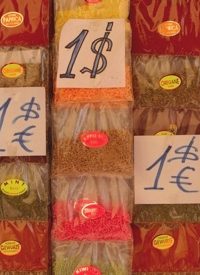
As world food prices continue to approach crisis levels, and global demand continues to increase, one international organization, The World Economic Forum, warns of possible “social and political instability.” In particular, the cost of corn and soybeans has skyrocketed to the highest they’ve been since July 2008, and experts predict the costs will continue to edge upward.
What’s worse is that price gains are expected to impact food costs for consumers and raw material costs for businesses, including ethanol producers and livestock producers.
The Blaze reports:
The Agriculture Department predicted this year’s corn production will fall about 4.9 percent to 12:45 billion bushels. That would leave inventories at the end of the season at about 745 million bushels, compared with 1.7 billion bushels in the previous year. On a global scale, the agency forecast inventories to decline 3 million tons, with more than two-thirds of fall coming in the United States.
Ethanol producers continue to purchase corn after the Obama administration approved the sale of gasoline with 15 percent ethanol, an increased percentage from the current blend. However, trade groups are in the process of challenging that decision by the Obama administration.
The Agriculture Department predicts that soybean production will fall to 3.329 billion bushels, which brings the end of the season inventory down 11 million bushels.
In order to meet the growing need, Telvent DTN analyst John Sanow predicts that farmers would need to plant a large number of acres of spring wheat, corn, soybeans, and cotton to ease situation. In the interim, however, prices will continue to remain high.
The Blaze notes, “In contracts for March delivery, corn added 24 cents to settle at $6.31 a bushel, soybeans gained 58 cents to $14.15 a bushel and wheat rose 11 cents to $7.705.”
Joseph Glauber, chief economist for the United States Department of Agriculture, indicates, “The markets are very, very tight. There is concern, no doubt.”
The impact of the crisis exceeds well past the United States into the rest of the world. The World Economic Forum released this week indicates a rising demand for basic necessities like food, water, and energy.
According to the report, “A growing global population and greater prosperity are putting unsustainable pressures on resources. It also raised the issue of shortages, which could cause social and political instability, geopolitical conflict, and irreparable environmental damage.”
In addition to food, oil prices continue to go up as crude oil supplies decrease.
Growing food prices could have a dangerous social impact on nations, like Tunisia and Algeria, where widespread riots rage over soaring unemployment and soaring sugar, flour, and oil prices. Though the government has since agreed to slash import taxes on those staples, the protests have not dwindled.
Likewise, the United States military has been taking the necessary precautions to prepare for potential economic disaster and social unrest in the United States. In fact, the Pentagon’s Unified Quest 2011 is a training program in which soldiers are prepared for evacuation and detainment as a response to rioting related to economic disaster. According to a CNBC report:
All different parts of the Pentagon and Defense Intelligence establishment are looking at markets and looking at ways they can present a new kind of threat to the United States. These are the guys whose job it is to think of the worst possible things that could happen.
Blacklisted News asserts that the Unified Quest 2011 is just one of my indicators that the world is headed towards economic disaster. Other examples include the decentralization of FEMA from a single distribution center in Washington to 15 regional facilities across the nation. Other global powers are equally preparing for such scenarios, including Russia, which has reportedly been preparing for the development of 5,000 new underground bunkers. Similarly, the European Union has allegedly commissioned the building of a “Doomsday Seed Vault” several hundred feet below sea level.
Gulf News writes, “With food supplies and prices making headlines around the globe for the second time in less than three years, experts are warning of the possibility of social unrest sweeping through poor countries.”
UAE-based economist Mohammad Al Assoomi states, “I can’t say for sure whether [social unrest] will happen. I believe things are moving towards increasing prices, and this could be absorbed by rich countries. But in poor countries, most segments of society won’t be able to handles these increases.”
In Asian countries, for example, food inflation has entered the double digits. Kenya’s government has already had to issue drought and famine alerts.
When asked about the impact of soaring food prices on social stability, Abdolreza Abbassian, an economist at the United Nations’ Food and Agricultural Organization (FAO) remarked, “We are entering danger territory.”
Perhaps offering some comfort, Abbassian contends that world food prices have still not yet reached the level they did when food riots hit almost 30 countries in the West, like Bangladesh and Haiti.
However, the good index jumped to 214.7 points from the peak recorded in June 2008. Additionally, the FAO reports that the prices of sugar and meat are at their highest since the first recorded levels in 1990. As far as wheat, rice, and corn, prices are sitting at the 2008 crisis levels.
Some nations are calling on the Group of 20 leading economies to take steps to aid the poorer countries and ensure that they are receiving adequate food supplies.
World Bank President Robert Zoellick asserts, “By empowering the poor the G20 can take practical steps towards ensuring the availability of nutritious food.”




